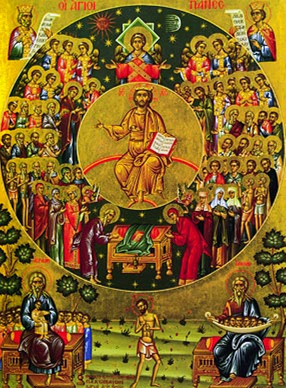Sunday of all Saints

The first Sunday after the Feast of Holy Pentecost, the Orthodox Church celebrates the Sunday of All Saints. On this day, we commemorate all of the Saints, all the Righteous, the Prophets, Apostles, Martyrs, Confessors, Shepherds, Teachers, and Holy Monastics, those who are known to us, and those who are known only to God, both men and women alike, who have been added to the choirs of the Saints and shall be added, from the time of Adam until the end of the world, who have been perfected in piety and have glorified God by their holy lives. The descent of the Holy Spirit makes it possible for us to rise above our fallen state and to attain sainthood, thereby fulfilling God's directive to "be holy; for I am holy" (Lev. 11:44, 1 Peter 1:16). We are all called to be Saints! Whenever St. Paul used to write to Christians, he used to write to them as the "Saints of Ephesus", or the "Saints of Thessaloniki". The icon of the SUNDAY OF ALL SAINTS depicts our Lord and Savior Jesus Christ seated above the throne of heaven surrounded by the Saints, the Archangel Michael and other Angels, the Theotokos and John the Baptist, the Apostles, Bishops, Great Martyrs, Ascetics and Monastics. To the side of the throne are Adam and Eve, bowing in reverence to Christ. At the lower left of the icon is the Patriarch Abraham who has a righteous soul in his bosom, as told in the story of Lazarus and the rich man in the Gospel. At the lower center is the Good Thief who was crucified with Christ. On the lower right is the Patriarch Jacob. ALL SAINTS DAY has always been observed not only as an opportunity for the Church to project to her living membership Christian ideals to be emulated, but also as an opportunity to establish a unity between the Triumphant Church of Christ in heaven and His militant one on earth.
Dimanche de tous les Saints
Le premier dimanche après la Pentecôte est dédié à la commémoration de tous les saints. La sainteté est l’œuvre de l’Esprit ; toute la sainteté chrétienne est un fruit de Pentecôte. Il y a donc une sorte de lien logique entre la fête de ce jour et celle du dimanche précédent. La sainteté, au sens du Nouveau Testament, est simplement l’état d’une âme unie à Dieu par l’opération du Saint-Esprit. En ce jour, nous commémorons les apôtres, les prophètes, les pontifes et les martyrs, le chœur des vénérables, les justes de tous les temps, l’assemblée des saintes femmes, les anonymes ainsi que ceux que nous connaissons et qui ont été ajoutés aux chœurs des saints depuis le temps d’Adam et jusqu’à la fin du monde. La descente du Saint-Esprit nous permet de nous élever au-dessus de notre état déchu et d’atteindre la sainteté, accomplissant ainsi la directive de Dieu consistant à « (être) saint ; car je suis saint » (Lé. 11:44 ; 1 Pierre 1:16). Nous sommes tous appelés à être des saints! Chaque fois que Saint Paul écrivait aux chrétiens, il leur écrivait en tant que « saints d’Éphèse » ou « saints de Thessalonique ». L’icône du DIMANCHE DE TOUS LES SAINTS représente notre Seigneur et Sauveur Jésus-Christ assis au-dessus du trône céleste entouré des saints, de l’archange Michel et des autres anges, de la Mère de Dieu et de Jean-Baptiste, des apôtres, des évêques, des grands martyrs, des ascètes. Adam et Ève se tiennent du côté du trône, se prosternant devant le Christ. En bas à gauche se trouve le patriarche Abraham. Au centre inférieur se trouve le bon larron qui a été crucifié avec Jésus. En bas à droite se trouve le patriarche Jacob. LA JOURNÉE DE TOUS LES SAINTS est non seulement une occasion pour l’Église de projeter les idéaux chrétiens, mais aussi comme une occasion d’établir une unité entre l’Église triomphante du Christ au ciel et Son église militante sur terre.